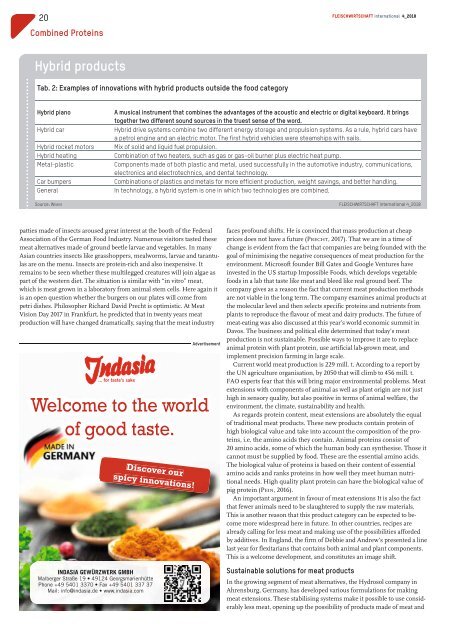FLEISCHWIRTSCHAFT international_04_2018
- No tags were found...
Create successful ePaper yourself
Turn your PDF publications into a flip-book with our unique Google optimized e-Paper software.
................................................................................................................................................................<br />
20<br />
Fleischwirtschaft <strong>international</strong> 4_<strong>2018</strong><br />
Combined Proteins<br />
Hybrid products<br />
Tab. 2: Examples of innovations with hybrid products outside the food category<br />
Hybrid piano<br />
Hybrid car<br />
Hybrid rocket motors<br />
Hybrid heating<br />
Metal-plastic<br />
Car bumpers<br />
General<br />
A musical instrument that combines the advantages of the acoustic and electric or digital keyboard. It brings<br />
together two different sound sources in the truest sense of the word.<br />
Hybrid drive systems combine two different energy storage and propulsion systems. As a rule, hybrid cars have<br />
a petrol engine and an electric motor. The first hybrid vehicles were steamships with sails.<br />
Mix of solid and liquid fuel propulsion.<br />
Combination of two heaters, such as gas or gas-oil burner plus electric heat pump.<br />
Components made of both plastic and metal, used successfully in the automotive industry, communications,<br />
electronics and electrotechnics, and dental technology.<br />
Combinations of plastics and metals for more efficient production, weight savings, and better handling.<br />
In technology, a hybrid system is one in which two technologies are combined.<br />
Source: WEBER <strong>FLEISCHWIRTSCHAFT</strong><strong>international</strong> 4_<strong>2018</strong><br />
patties made of insects aroused great interest at the booth of the Federal<br />
Association of the German Food Industry. Numerous visitors tasted these<br />
meat alternatives made of ground beetle larvae and vegetables. In many<br />
Asian countries insects like grasshoppers, mealworms, larvae and tarantulas<br />
are on the menu. Insects are protein-rich and also inexpensive. It<br />
remains to be seen whether these multilegged creatures will join algae as<br />
part of the western diet. The situation is similar with “in vitro” meat,<br />
which is meat grown in a laboratory from animal stem cells. Here again it<br />
is an open question whether the burgers on our plates will come from<br />
petri dishes. Philosopher Richard David Precht is optimistic. At Meat<br />
Vision Day 2017 in Frankfurt, he predicted that in twenty years meat<br />
production will have changed dramatically, saying that the meat industry<br />
Advertisement<br />
faces profound shifts. He is convinced that mass production at cheap<br />
prices does not have a future (PRECHT, 2017). That we are in a time of<br />
change is evident from the fact that companies are being founded with the<br />
goal of minimising the negative consequences of meat production for the<br />
environment. Microsoft founder Bill Gates and Google Ventures have<br />
invested in the US startup Impossible Foods, which develops vegetable<br />
foods in a lab that taste like meat and bleed like real ground beef. The<br />
company gives as a reason the fact that current meat production methods<br />
are not viable in the long term. The company examines animal products at<br />
the molecular level and then selects specific proteins and nutrients from<br />
plants to reproduce the flavour of meat and dairy products. The future of<br />
meat-eating was also discussed at this year’s world economic summit in<br />
Davos. The business and political elite determined that today’s meat<br />
production is not sustainable. Possible ways to improve it are to replace<br />
animal protein with plant protein, use artificial lab-grown meat, and<br />
implement precision farming in large scale.<br />
Current world meat production is 229 mill. t. According to a report by<br />
the UN agriculture organisation, by 2050 that will climb to 456 mill. t.<br />
FAO experts fear that this will bring major environmental problems. Meat<br />
extensions with components of animal as well as plant origin are not just<br />
high in sensory quality, but also positive in terms of animal welfare, the<br />
environment, the climate, sustainability and health.<br />
As regards protein content, meat extensions are absolutely the equal<br />
of traditional meat products. These new products contain protein of<br />
high biological value and take into account the composition of the proteins,<br />
i.e. the amino acids they contain. Animal proteins consist of<br />
20 amino acids, some of which the human body can synthesise. Those it<br />
cannot must be supplied by food. These are the essential amino acids.<br />
The biological value of proteins is based on their content of essential<br />
amino acids and ranks proteins in how well they meet human nutritional<br />
needs. High quality plant protein can have the biological value of<br />
pig protein (PEIN, 2016).<br />
An important argument in favour of meat extensions It is also the fact<br />
that fewer animals need to be slaughtered to supply the raw materials.<br />
This is another reason that this product category can be expected to become<br />
more widespread here in future. In other countries, recipes are<br />
already calling for less meat and making use of the possibilities afforded<br />
by additives. In England, the firm of Debbie and Andrew’s presented a line<br />
last year for flexitarians that contains both animal and plant components.<br />
This is a welcome development, and constitutes an image shift.<br />
Sustainable solutions for meat products<br />
In the growing segment of meat alternatives, the Hydrosol company in<br />
Ahrensburg, Germany, has developed various formulations for making<br />
meat extensions. These stabilising systems make it possible to use considerably<br />
less meat, opening up the possibility of products made of meat and

















